If you're new here, you may want to subscribe to my RSS feed. Thanks for visiting!
Author of Be Ready for Anything and Bloom Where You’re Planted online course
Here’s my recommendation for your end-of-summer food preservation.
You need 100 pounds of tomatoes.
100 pounds? Are you insane, Daisy?
Yes – 100 pounds, and more if you can get them. No other item of produce increases in nutrients when cooked and stored like tomatoes. Canning them is like loading your shelves with vitamins. These vitamins have the delicious bonus of providing tasty meals throughout the winter when fresh fruits and veggies are expensive (and scarce for many of us if you prefer to consume foods grown close to home.) I got most of my tomatoes from local friends who had an over-abundance, so I didn’t pay a lot for them. You can often find tomatoes by the bushel for $1-2 per pound at your local farmer’s market. (Find a farm or market near you at Eat Local Grown.)
So here are your five reasons, as well as instructions and recipes for prepping and canning these vitamin-laden goodies.
Simple sauce with tomatoes, onions, and garlic
Tomato broth
Italian marinara
Salsa
Ketchup
If you purchased all of these items organic, over the course of the year it would cost at least triple the price of spending a few days making it yourself.
Here are the kitchen tools that I use to make these goodies. They are not all 100% necessary but they make the work easier. Don’t let the lack of these things deter you if money is an issue – just adapt what you have to make it work!
Excelsteel 16 Quart Stainless Steel Stockpot With Encapsulated Base
Ninja Mega Kitchen System (BL770)
Presto 01781 23-Quart Pressure Canner and Cooker
Natural Flour Sack Kitchen Towels
Roma Food Strainer and Sauce Maker for Fresh Fruits and Vegetables
Granite Ware 0718-1 Enamel-on-Steel Canning Kit, 9-Piece
ExcelSteel 242 5-Quart Stainless Steel Colander
Prepping tomatoes for canning
The first step for all of these recipes is to wash and peel your tomatoes.
I always soak my fruits and veggies in a baking soda wash, whether they are organic or not. Add one cup of baking soda to tepid water, soak, then rinse well.
Next, you have to peel your tomatoes. The easiest way to peel tomatoes is to take them from boiling water to an ice bath and then squeeze the guts out of them, as follows.
First, put water on to boil in a large non-reactive stockpot. (I prefer stainless steel.) You don’t need to wash or cut the tomatoes before blanching them. In batches, place the tomatoes into the boiling water for about 3 minutes. (This time is not engraved in stone – don’t panic if you go over the time by a little bit.)
You can test them by gently using your tongs to see if the skins have loosened. After you scoop the tomatoes out of the boiling water, place them directly into an ice bath and leave them there for at least 3 minutes. I like to use long tongs for this because you transfer less of the hot water into your ice bath.
Once the tomatoes are cool enough to easily handle, use your fingers to dig the stem end out of the tomato and discard it. Then, squeeze the tomato over your blender – the skin should slide right off and leave you with a blender full of pulp. You don’t need to remove the seeds.
Now you’re ready to can tomatoes.
#1 – Simple Tomato Sauce
This thin puree is as simple as running your tomatoes through the blender and possibly adding some garlic, onions, and salt to them. It can be used as a base for soup, chili, spaghetti sauce, enchilada sauce, or any other purpose that requires crushed tomatoes. I like to can this because it’s pretty neutral and can be used in so many different recipes throughout the year.
I didn’t give measurements, because this simple sauce can be made from any amount of tomatoes that you happen to lay hands upon. It is also a great way to use up soft or overripe tomatoes quickly.
Ingredients:
- Peeled tomatoes (any variety)
- 1/2 a small onion per jar
- 1 clove of garlic per jar
- Sea salt or canning salt to taste
- Lemon juice
Directions:
- Peel tomatoes and place them directly into the bowl of your food processor or pitcher of your blender. Approximately 3 cups of unprocessed tomato will fill a quart jar. If you’re using onions and garlic, add those to the food processor at the same time.Use the pulse option on your processor until the mixture reaches your desired consistency.
- Pour this into a sanitized quart jar.
- Repeat until you have a canner load of sauce.
- Add a dash of salt to each jar. If you are water bath canning, add 2 tbsp of lemon juice to each jar. If you are pressure canning, the lemon juice is not necessary.
- In a water bath canner, process your sauce for 40 minutes at sea level, adjusting for altitude. Alternatively, you can process the sauce in your pressure canner for 25 minutes at 10 pounds of pressure, adjusting for altitude.
The Whole Buffalo Theory of Tomatoes
I’ve been experimenting with ways to get more mileage from my food this year, something my daughter refers to as “using the whole buffalo.” I began straining my fruit purees before making jam and had great results, so instead of cooking my tomatoes down for hours and letting all of that goodness just evaporate, I decided to use the same method with some of my tomato products.
When processing my tomatoes for marinara, salsa, and ketchup, I decided to see if I could cut down the cooking time and preserve the extra liquid for a vegetable broth base for soup or cooking rice.
After I pureed my veggies, as per the directions in all of the recipes, I poured the puree into a colander that was resting over a large stockpot.
I left it to drain for anywhere from 2 hours to overnight. The longer it drains, of course, the less liquid will remain in the sauce. The liquid that drains off can then be processed as a tomato broth for soup.
This is what you’ll be left with – thick tomato-ey goodness that doesn’t require a half-day of cooking to reach the proper consistency! What you do from here is based on what you plan to make. For salsa, I use the tomatoes as they are. For marinara sauce or ketchup, I run it through the blender again to get a nice smooth puree.
That’s not the only way you can extend your tomatoes. Did you know that you can make a thick sauce from the peels? As with most fruit, this is the part that contains the most pectin.
When peeling your tomatoes, simply peel them over a small pot in order to catch any extra juice. When you’re done, simmer the peels in the juice for a few hours. At this point, you have two options.
1.) Allow the mixture to cool. Strain it over a mesh colander into a pot, then squeeze out the peels to get the thick tomato paste from them.
2.) Use a mill like this one to separate the paste from the peels. (This is the most effective method and will net you the most sauce.)
Learn more about making sauce from tomato peels HERE.
#2 – Tomato Broth
Strain your liquid as described above.
Pour this into a sanitized quart jar.
Add a dash of salt to each jar. If you are water bath canning, add 2 tbsp of lemon juice to each jar. If you are pressure canning, the lemon juice is not necessary.
In a water bath canner, process your sauce for 40 minutes at sea level, adjusting for altitude. Alternatively, you can process the broth in your pressure canner for 20 minutes at 10 pounds of pressure, adjusting for altitude.
The liquid will separate, as you can see in the photo above, and you will have tomato “sediment” at the bottom. This is perfectly normal. This broth can be used as a base for soup, in place of liquid for cooking meat in the crockpot, or for cooking rice.
Now, with your drained tomatoes, you can make the following products.
#3 – Marinara
If you have already drained your tomatoes, gauge your recipe to approximately 3 cups of rough puree per quart jar.
For a 7 quart batch, you will need 2 bell peppers, any color, 2 onions, and 1-2 heads of garlic.
In batches, puree your tomatoes and veggies until smooth, then add them to a large stockpot.
Add the following seasonings – the first amount is per pound of tomatoes, and the second amount is for a 7 quart batch of sauce.
- 1 tbsp – sugar – 1/3 cup
- 1 tsp – sea salt – 2 and 1/2 tbsp
- 1 tsp – thyme – 2 and 1/2 tbsp
- 1 tbsp – oregano – 1/3 cup
- 1 tbsp – basil – 1/3 cup
- 1 pinch – powdered clove (trust me!) – 1 tbsp
- black pepper to taste
- 1 pinch – paprika (smoked Hungarian if you can find it) – 1 tbsp
- 2 tbsp – extra virgin olive oil – 2/3 cup
With the lid off, bring the sauce to a simmer for about an hour, stirring occasionally. This will allow all of the seasonings to meld into the sauce.
If at serving time your sauce is still runnier than you prefer, simply stir in a small tin of tomato paste to thicken it.
- Fill sanitized quart jars with sauce, allowing 1 inch of headspace.
- Wipe the lip of your jars with a cloth dipped in white vinegar and then place the lids on.
- Process the sauce in your pressure canner for 25 minutes at 7 pounds of pressure, adjusting for altitude.
- Allow the jars to cool undisturbed for at least 12 hours or until cooled. Test the seals before putting them away.
#4 – Salsa
Ingredients:
- 14 cups of drained tomatoes
- 4 bell peppers, seeded
- ½ cup of jalapeno peppers, with center removed (leave in seeds for super-spicy salsa, reduce or even eliminate the amount of jalapenos for a milder salsa)
- 2 medium onions
- ½ cup of lemon or lime juice
- 4 cloves of garlic
- ¼ – ½ cup of fresh cilantro leaves (if you HATE cilantro, you’re weird, but use parsley instead)
- 1 tbsp of turbinado sugar
- 1 tsp of chili powder
- ½ tsp of cumin powder
Directions:
- Dump your drained tomatoes into a large mixing bowl.
- Using your food processor, add the tomatoes, peppers, onion, garlic, and cilantro. Process on the “chop” function until you’ve reached the desired chunkiness, then pour each batch into the mixing bowl with the tomatoes.
- Once all of your veggies are in the bowl, stir in your lemon or lime juice and all of your seasonings until they are well combined.
- Ladle the salsa into the prepared jars that are eagerly awaiting it.
- Wipe the lip of the jars, place the flats and rings on them, and lift them into the vigorously boiling water bath.
- In a water bath canner, process your salsa for 25 minutes at sea level, adjusting for altitude. Alternatively, you can process the sauce in your pressure canner for 15 minutes at 10 pounds of pressure, adjusting for altitude.
#5 – Ketchup
Once you try this taste-of-summer condiment, those little packets and squirt bottles will never satisfy your ketchup craving again. Plus, it’s real tomato-y goodness without all of the additives.
Ingredients:
- 12 cups of drained tomatoes
- 2 onions, quartered
- 2 sweet peppers
- 1-1/2 cups of cider vinegar
- 1/2 cup of brown sugar
- 1 tbsp of salt
- 1 tsp of celery seed
- 1/2 tsp ground allspice
- 1 tsp ground cloves
- 1/4 tsp ground cinnamon
Directions:
- Using your blender, puree your drained tomatoes with the peppers and onions – you will have to do numerous batches. Pour each pureed batch into a large stockpot.
- Bring the mixture to a boil, then reduce heat and simmer it for one hour, uncovered.
- Stir in the vinegar and spices and continue to simmer with the lid off. It will take 1-2 hours to reach a desirable consistency.
- Once the ketchup is at your preferred consistency, ladle it into pint jars.
- Lid the jars and process them in a water bath canner for 15 minutes, adjusting for altitude.
Boom….100 pounds of tomatoes in your pantry!
See? 100 pounds of tomatoes isn’t actually unrealistic at all. If you are lucky enough to have even more of a tomato harvest, simply rinse and repeat the above recipes. My goal is to stockpile enough heirloom tomato products that there’s no need to purchase the nasty, high-fructose corn syrup, BPA-tainted storebought items all winter.
If you happen to have extra tomatoes, slice them up and put them in the dehydrator. You can store these in olive oil for delicious gourmet additions to pizzas and salads.
How do you preserve your tomatoes?
Resources
Excelsteel 16 Quart Stainless Steel Stockpot With Encapsulated Base
Ninja Mega Kitchen System (BL770)
Vitamix 5200 Series Blender, Black
Presto 01781 23-Quart Pressure Canner and Cooker
How to Can Food in a Boiling Water Bath
Roma Food Strainer and Sauce Maker for Fresh Fruits and Vegetables
Granite Ware 0718-1 Enamel-on-Steel Canning Kit, 9-Piece

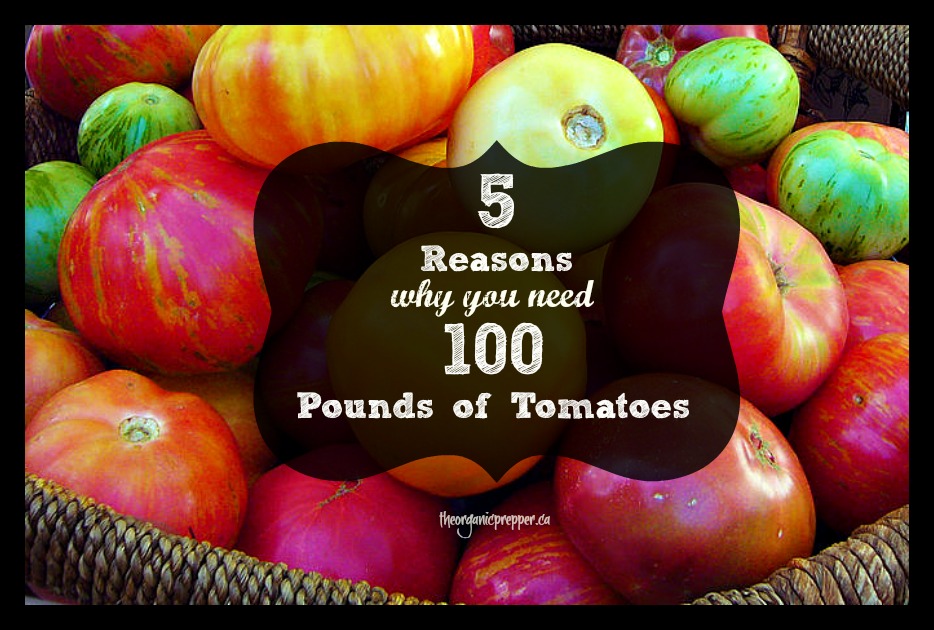
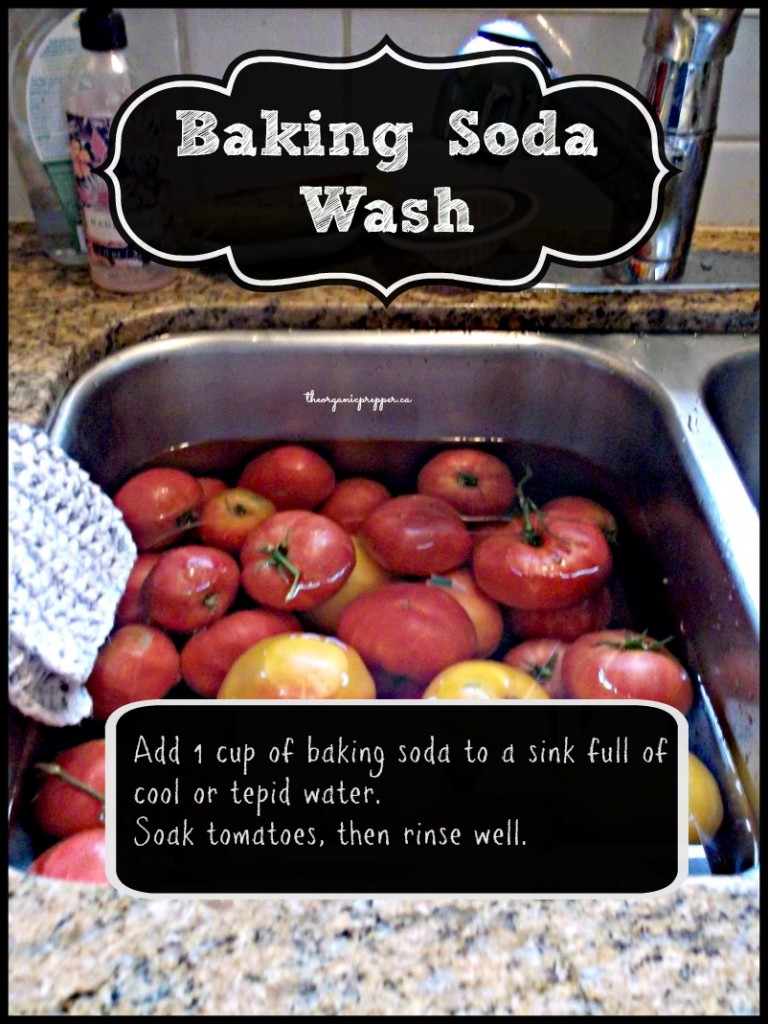
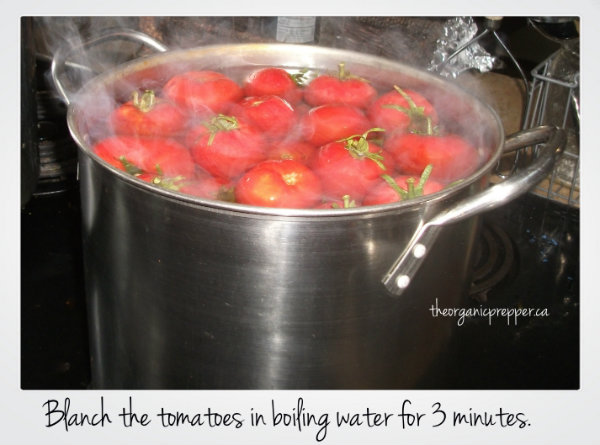
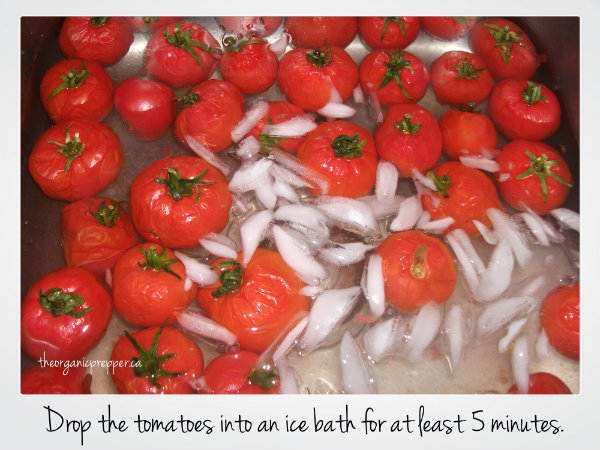
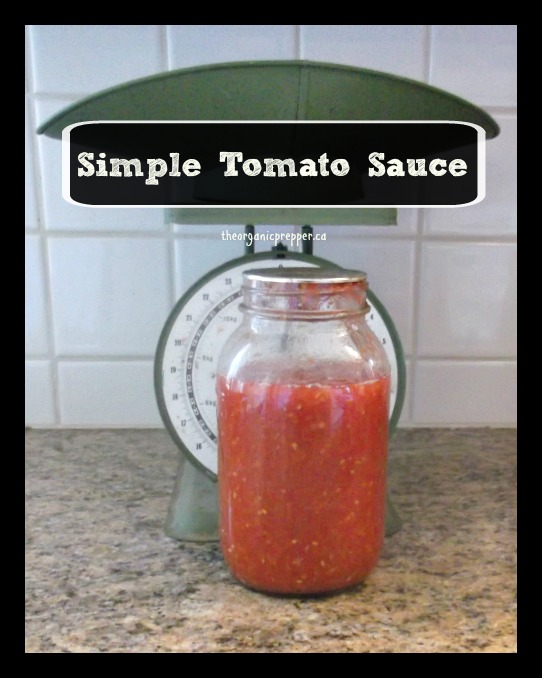
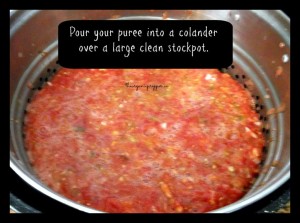
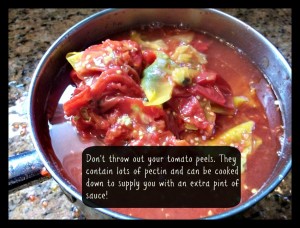
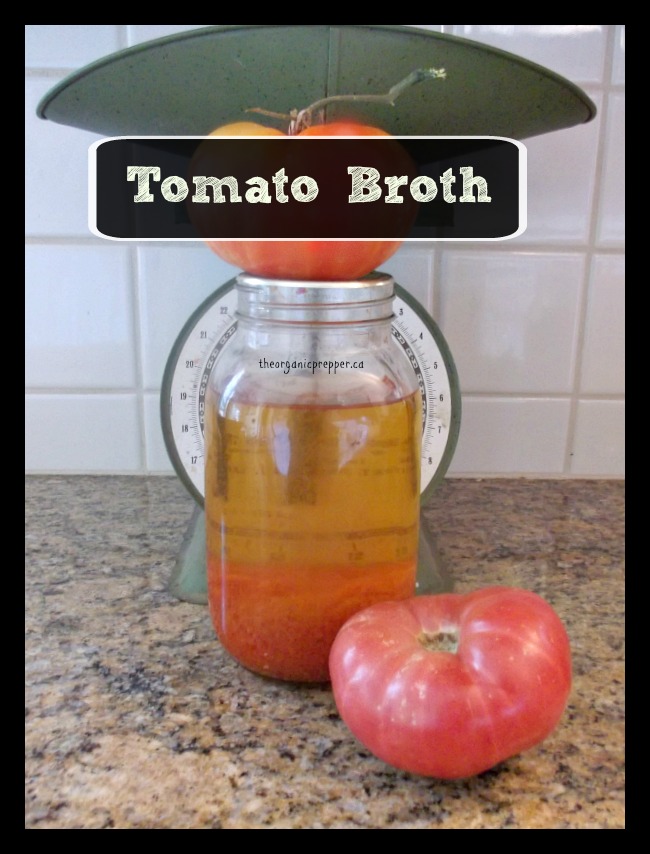
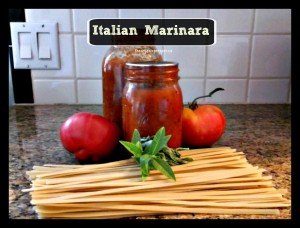
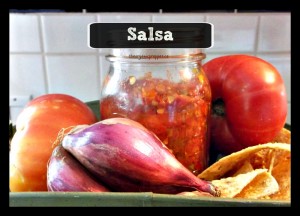
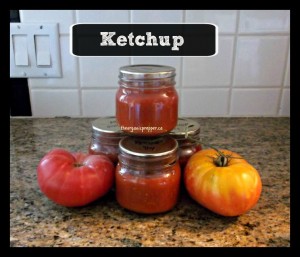














31 Responses
Boom! Brilliant. I’m on it.
We just finished up 125 quarts of spaghetti sauce…years worth of dinners. We buy the tomatoes from a local farmer, including the veggies we add to the sauce. We cook it down just long enough to get it to a 220 degree heat. It makes for great pasta sauce, chili and soup bases…and awesome bloody mary’s 🙂
I should correct myself a “year’s” worth of dinners 🙂
We are up to our elbows in canning puree as I write. Two more bushels to go. Spices and additions are added when I prepare the meal.
We use the Victorio Strainer hand model for several years now. I also purchased the accessory strainers. It saves a tremendous amount of time. The chickens get the skins/seeds.
At least for the tomatoes, the strainer was not about the seeds, it was about the time it takes to peel the skins. The strainer is a blessing.
As usual, life got in the way during produce season, but even with several unplanned major events, we were able to put up quite a bit. I am not done yet!
I’m so excited to read this post!! In the past few days, all our tomato plants have withered and died!! So…I have to pick every tomato. The green ones will become either pickles or wrapped in newspaper and placed in paper bags to ripen. The red I’m going to can as simple stewed tomatoes…some of the batches I’m going to try your idea of straining the liquid for soups!! Since I haven’t been able to afford a pressure canner yet, I’m saving your recipes and will make them as I need them. Thank you!!
Mom of 5 – many of these could be frozen if you don’t have pressure canner. 🙂 Here’s a recipe for those green tomatoes – it’s from my upcoming cookbook.
This can be mixed with a basic white sauce to create the best enchilada sauce on the planet!
Ingredients
• 7 cups of green tomatoes
• 3 jalapeno peppers
• 1 green bell pepper
• 2 large onions
• 3 cloves garlic
• ½ cup lime juice
• ½ cup of cilantro
• 2 tsp ground cumin
• 1 tsp salt
Directions
1. Using a food processor, chop tomatoes, peppers, onions, and garlic until they reach the desired chunkiness.
2. Pour the processed veggies into a large stock pot. Stir in cilantro, cumin, salt and lime juice.
3. Bring to a boil, then reduce heat and simmer for 5 minutes
4. Ladle green salsa into your ready-n-waiting pint jars, leaving a half inch of headspace at the top.
5. Process the jars in a water bath canner for 20, adjusting for altitude.
Thanks Daisy!! I would put them in the freezer but my big deep freezer died a week ago. I managed to get most of the food into our 2 refrigerator freezers, but no more room. And thanks for the recipe for green tomatoes!! Definitely going to try it out!!
Just took a break for a moment….canning tomato dices. Tomatoes were a little wonky from my garden this year. I may have to look into picking up a few. Since I grew my plants from seed, three pints of home canned dices pays for everything.
Excellent article Daisy! You are just the ticket for my confirmation endorphins. I planted 107 tomato plants this summer and have been canning nonstop for over a month now. Salsa, canned tomatoes, chili, tomato soup, spaghetti sauce, pizza sauce, bbq sauce and chowchow. I know it seems a bit compulsive, but I swear I can stop any time I want lol. http://twoicefloes.com/tomato-mania/
Great post Daisy! First frost last night & 2 more frosty nights predicted so its a good thing we brought all those green tomatoes in. A few years ago we decided to try to cut out buying orange juice & try to just use tomato juice. Therefore a lot of our tomatoes go to juice. Most of the rest just goes to canned tomatoes. We don’t use much pasta sauce as we grow a lot of potatoes & they keep well in our root cellar so we don’t have to buy much pasta. Maybe it would be good on potatoes instead of butter. Just a new thought. Could cut down on buying another product. We also have the Victorla strainer. Excellent product. Use it lots for tomatoes & apple sauce. Never made marinara sauce. Is it a pasta sauce or for other things also?
Marinara is a pasta sauce, but since we are gluten free, we use it on rice or chicken most frequently 😀 It makes nice pizza sauce too!
You might try using a steam juicer. I get the tomato “broth” out of it. Along with drastically reduced cooking times for the follow up recipes.
I read your post with great interest Daisy because i just canned up my first homegrown batch of tomatoes this past saturday and thoroughly enjoyed the entire process. Several of my friends said that canning was hard work but I didn’t find it so. perhaps because I canned my ‘maters in small batches. the first batch was only 6 pints and I was gratified to see the jar lids seal tightly.
I’ll be canning another similar sized batch tonight after work and probably several more times over the next month or two. I do have around 70 to 80 pounds of tomatoes coming out of my garden.
I’ll probably have 3 dozen jars of tomatoes canned up for winter and gifts for friends.
I love your idea for using tomato juice for a Bloody Mary and will be canning up that yummy juice for future use.
best!
Snake Plisken
Nice…
We go through a lot of sauce throughout the year. Other than a few quarts of stewing tomatoes, we make all the tomatoes into sauce. It gets used for pizza, spaghetti, chili, and hamburg gravy over mashed taters.
It’s nice to have the home grown green peppers, garlic and onions to add to the sauce. I admit that I keep my eyes open in the off season for scratch and dent tomato paste because we like THICK sauce and I’m too lazy to wait all day for it to cook off. lol.
Awesome im just waiting for the green to turn red. I dont think I have 100lbs. Only eight plants doing good this year. But I know what to get at farmers market now to supplement my garden
Great article, it’s great to see “Self-Reliant” people preparing their food from scratch while building a network of good neighbors. I’m gonna pick up the cooking supplies mentioned above and do the same. The SurvivAllExpert
I really like tomatoes, especially the fresh kind, how-freaking-Ever; I saw this bit about parasites, and I remembered how during the Very Hot Summer months during the dry spell I saw mosquitoes swarming my tomatoes and they were seemingly biting them the same way they bite People.
Which got me to thinking, are mosquitoes biting tomatoes and giving People parasites the same as if the mosquitoes were biting the People?
I dunno, just an observation I thought I’d share.
I’ll still eat raw tomatoes, but I think cooked is the best way to have them.
Pardon me, I know it’s not something you wanna think about when you’re talking tomatoes, but here it is:
‘Eliminating The Parasites That You Almost Certainly Have, and Curing Lupus’
https://healthwyze.org/index.php/component/content/article/243-eliminating-the-parasites-that-you-almost-certainly-have-and-curing-lupus.html
Another thing you can do with the leftover skins and seeds are to dehydrate what is left after putting your tomatoes through the food mill and then crushing them in a Vitamix or similar food processor. What you have is a powdered tomato mix which can be used to firm up sauces, add flavors to soups and stews or whatever else you can think up.
Oh I love that idea, Susan! I’m going to do that with the next batch!
~ D
Hi Daisy,
For the Ketchup recipe should the tomatoes be peeled? Also, how long should I process the Marinara sauce if I am doing it the bath water process.
Thanks!
Blanca: Yes, peel the tomatoes. With the marinara sauce I strongly recommend pressure canning because it contains olive oil and lots of other ingredients besides tomatoes. There are waterbath marinara recipes out there on the net that don’t have such a high percentage of other ingredients 🙂
Another use for the peels. As you peel the tomatoes put the peels in a single layer on your dehydrator shelves & process until completely dried out. Then process in batches in coffee grinder (non-burr style) or food processor to a fine powder. I use a couple of tablespoons in a batch of spaghetti, soups etc for an extra punch of flavor. Also when making beef bone broth in addition to the other vegetables (celery, carrots, onions) I add a couple tablespoons of tomato powder.
I learned this from a video on Our HalfAcre Homestead. Dehydrate the tomatoes. (She recommended peeling and deseeding) Take the pieces and put the through the blender grinding them into a medium-fine powder. To use take 1 cup of boiling water to 1 Tablespoon powder. Add pizza seasonings. Perfect amount for 1 pizza.
two additions: first, you can skip all that boiling water/ice baths/skinning stuff if you don’t need your tomato product right away. if you wash and core your ripe tomatoes and freeze, when thawed, the skins come off easily. i do my tomato canning in november, when i appreciate the added heat and moisture in my kitchen. second, while i often remove skins, i never remove seeds. why? because the seeds may be the most nutritious part. think about it…the plant put extra nourishment in the seed to grow the baby plant. i want that! i use an immersion blender on my sauce and my katsup. you hardly see those seeds. think of it as your special signature on your product.
I’m 69. I’ve been canning spaghetti sauce for 45 years and last year learned something new from a 29 year old neighbor. I washed and cored the tomatoes and roasted them in the oven. Once roasted and cooled, I blended them and began my sauce at that point. Great taste!
wish you’d add a printer friendly version to your site
Daisy, for the simple sauce recipe, what kind of headspace do you leave in the quart jars? I’m VERY new to canning, so I’m gonna try the easy recipe first. Thanks!!
Go with a half-inch of headspace. You’re going to do great!
Thanks! I’m a new prepper, and we’re in southeastern Virginia, so I’m trying to do my bit before hurricane season and stock up shelf stable items instead of just filling my freezer.
I LOVE tomatoes! And, Yes Ma’m I can as many as I can get my hands on. I have to try that ketchup recipe though. 😀
After reading this, I just told my wife that we should take advantage of a lot of empty space in our freezer and stock it with tomatoes. Thanks for the info!!